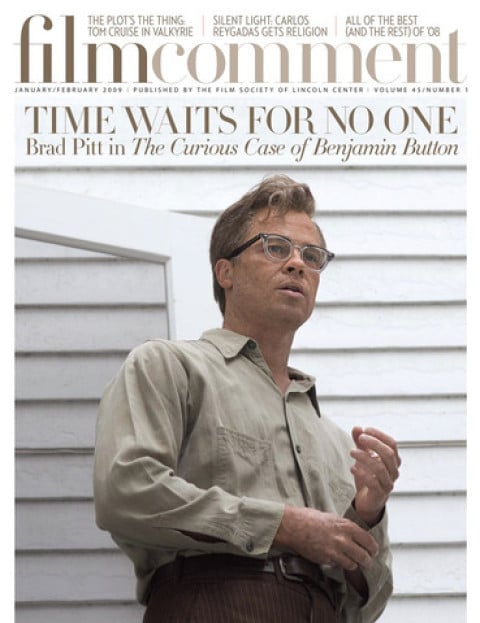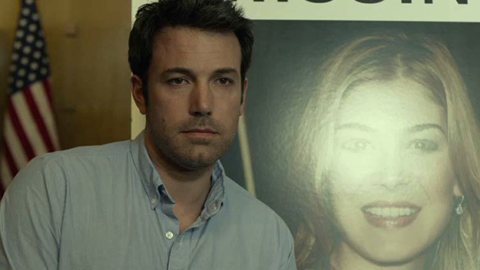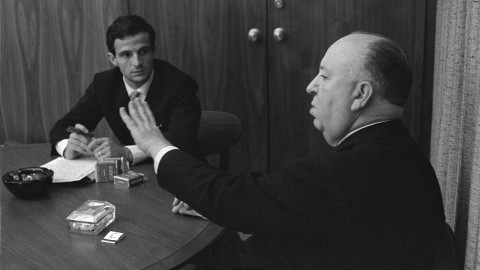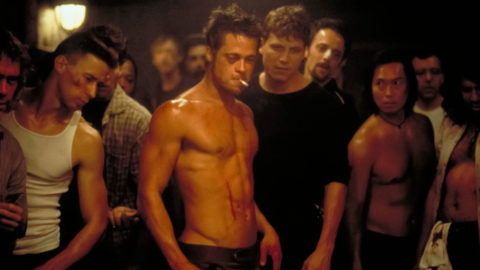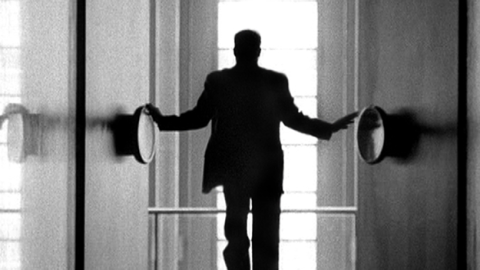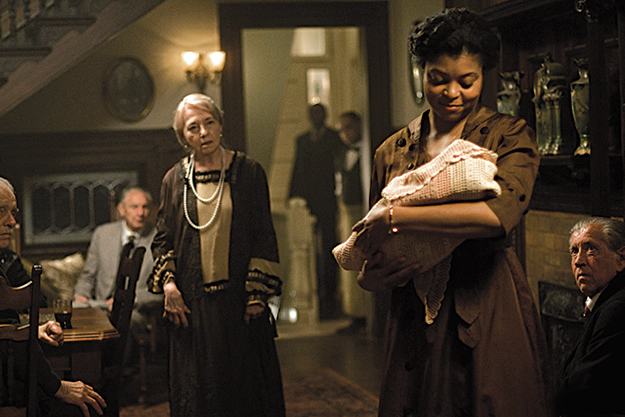
DAVID FINCHER: It took for fucking ever. We were supposed to make it before Zodiac. Sherry Lansing was running the studio and I think it was just too big a bite. It’s funny, you say to people $140 million or $150 million dollars and Hollywood is so screwed up that three years later it sounds like a bargain. I think it was just that the number was too daunting, and also, what is it? Is it an action movie? Is it Forrest Gump? When you say you’re making a movie about life and death for anyone who has had children or anyone who has had parents, Hollywood is not going to beat down your door.
AMY TAUBIN: And they still seem to be having trouble figuring out how to sell it. The poster I saw was, well, a bit vague.
It’s interesting. I made it with the idea in mind that it showed the fallacy in the idea that youth is wasted on the young. But some people come out of it saying, “You made the best case for youth is wasted on the young.”
I don’t see the second at all.
Neither do I. But again, I think people bring so much to it. If you’ve lost a parent, if you’ve sat there on that death watch… it’s a totally different situation for somebody who’s been through that than for somebody who hasn’t. I joked about this, but it really is true that when I tallied the list of things that everybody said I should cut, the movie was an hour and a half, and when I tallied the list of everything that people said you must not cut, the movie was four hours long. So at some point you have to do what feels right to you and call it a day.
I think it’s a terrific movie. I probably shouldn’t start with my only reservation—what I think you should have cut—but since you gave me the opening, I’d like to get it out of the way. I had problems with the framing story, and particularly with starting the film with such a long framing sequence. Because, for me, it does an odd thing: the reality of the movie is Benjamin’s story. I believe so much in that story that when you shift to a different register of realism in the hospital, it seems much less real. I never buy it—it seems to me just an actress lying in bed with a lot of make-up to make her look sick. Whereas everything else in the movie, I believed totally, or rather I had no problem suspending disbelief.
I felt you needed to be reminded of the mundane. I wanted to gut the tragedy. The tragedy is not that we all die, that’s just a given. So, I sort of know what you’re saying, but I felt structurally you needed it. And I think Eric [Roth, the screenwriter] felt strongly about it, and I feel he was right—you needed to get the experience through someone [Daisy and Benjamin’s daughter] who hadn’t experienced it. You couldn’t do it just as Daisy’s POV, It just not third party enough. Everything is like either he’s telling you this is what it’s like for me or she’s telling you. But it [the framing story] is designed to be semi-reliable.
During the Q&A at the DGA screening, Steven Soderbergh asked you how you set the tone of a fable? And you said something like you didn’t think of it as a fable. I don’t think of it as a fable either.
Yeah.
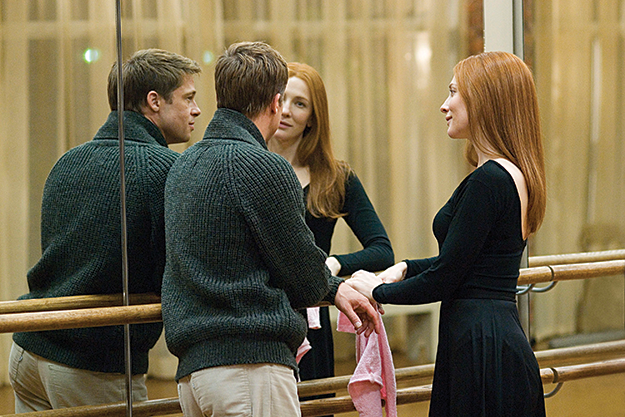
I think, in part, the reason is how movie time has affected us without us being consciously aware of it. It doesn’t seem so strange to me that someone would go backward in time—that his body as a biological entity would be programmed to go from the end to the beginning. The connection between Benjamin’s body clock and movies is specifically made in that sequence where Mr. Gateau, the clockmaker, describes how he wanted time to go backwards so that his son who died in the war could come back to life, and at that point, you see the war footage running backward. So movies have changed our experience of time and it’s just the next step for that experience to infiltrate our DNA. If the shot of the movie going backwards hadn’t been there, I might have found it harder to believe in Benjamin’s experience.
Again, this is what I love about Eric Roth: that all the people who posit these ideas are lunatics. Elias [Koteas] and I talked a lot about Mr. Gateau [Koteas’s character] and his sort of tilting at windmills. But I think it’s kind of like what Spielberg’s great at with visual effects. He posits the idea before he shows it to you and he has you rooting for it. When I read it [the scene of war going backwards] on the page I thought, is this going to work? A military charge running in reverse and seeing these people fly back together again? It’s the cheapest trick in cinema. It’s so simple and yet it’s a bold idea. And it’s played as such a quixotic moment. It has so much pathos. The combination of those elements is such an Eric Roth thing. You have empathy for him [Mr. Gateau] even though you don’t know who the hell he is. But you have empathy for a situation and then he makes crystal clear his hopes and desires in this very simple cinematic conceit.
I’m not a fan of Forrest Gump, to put it mildly. The first time I saw Benjamin Button, I wasn’t aware that Eric Roth wrote both films. But when I put that together, I watched Gump again and loathed it just as much. What’s strange is that the two films pose very different worldviews and yet they share so many narrative tropes and devices. For example the way the first person voiceover threads through both films.
Yeah, and particularly his flashes in time. I used to joke with Eric about “and we see just that.” We’d have the big discussion about the see-and-say. Are we going to see and say… because it’s funny but it’s easy. And when we got down to it, the only see-and-says we kept were the stuff that went right through everyone’s intellectual chain mail.
Would you explain see-and-say?
Whenever we had something that was talked about and we’d see it at the same time, we’d let it slide if we felt it was emotional—it would sort of cut through everything. For instance, [Mr.Gateau says] “Perhaps the boys that we lost in war might stand to come home again.” And then you illustrate it—you literally cut to it [the footage running backward]. And that was one of the moments where we said, well you’re going to have to do that. But for the most part we wanted things to stagger and be dovetailed. He [Benjamin] talks about something but it doesn’t happen just then. Because that kind of irony allows people to put up their emotional chain mail up. Like when he says “I met the person who would change my life forever,” and the first person he sees is his father across the street, and you go “maybe that’s who.” and then, of course, he turns around and there’s Daisy. So wherever possible we were trying to make sure you didn’t feel “well, I don’t need to listen to this because I’m just going to see it at the same time.” There was always a little bit of a trick being played unless it was one of those moments like the war footage running backwards. And you said, this is undeniable. This is going to be a powerful thing to witness at exactly the same time as he’s talking about it.
I think the voiceover is remarkable, in part because of Brad Pitt, who is wonderful in the film.
I love him so much in this movie. His most effortless performance ever and it’s the most difficult stuff to do.
And his accent seems, to my New York ear, pretty flawless.
Tim Monich [the dialogue coach] is good. I was terrified of the idea of accents, but we were down prepping it in New Orleans, and you know, you can’t have a Missouri accent, you can’t have a San Diego accent, you can’t be mid-Atlantic, we’ve got to do this. Tim was very conscious of making sure that a lot of elements of it were African-American because Benjamin was raised in that environment. We chose Virginia for his father’s accent—we wanted it to sound a little tonier, but the New Orleans accent has a nice homily.
I listened to you talking at the DGA about the motion capture, and I think I have a general idea of how you do it, but would it be too boring to ask you to run through the basics?
Intro to Facial Capture 101.
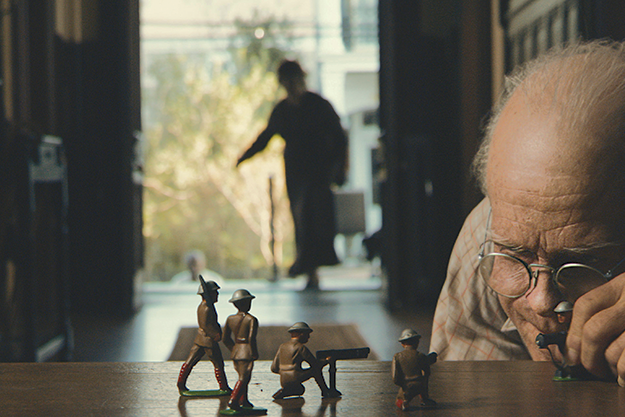
Even before we get to facial capture. What happens on the set, in the scenes where Benjamin looks old. You have small actors playing Benjamin. Where is Brad?
We don’t have Brad on the set. He’s never there [during those scenes].
And one or another of the small actors is doing the lines and walking through the blocking and interacting with the other characters?
That is correct.
But has Brad read the scenes with the other actors who are supposed to playing with him? Do the three small actors know what he’s going to do, or are they very good at capturing his rhythms or what?
Well, we cast them not so much for their acting ability. Peter Badalamenti plays Benjamin from when he’s 5 up until he’s about 9, basically the first four years of the movie—we meet him in a wheel chair and he gets up out of the wheelchair and he’s walking on two crutches, he goes out into the world with Mr. Oti on two crutches. So Peter’s greatest function and the things he had most to be aware of were where he was looking, and did it look like he had never walked before and was trying to walk on crutches, and was he looking at his Mom when his Mom was talking to him or was he looking away. He did the lines but a lot of the time his delivery was faster. But we were married to his head movement on the set, so takes were chosen depending on where he was in physical space, what his body was doing, and where his head was looking. And some times, we re-jiggered some of the text once Brad got in there and he said things a little differently, but we’d be locked into, not the eye-line, but the head position. Then there’s a hand-off to Robert Towers who plays Benjamin from [when he’s about] 10 to 15. We reintroduce Benjamin at the Thanksgiving Day party and he’s walking on one cane. That’s Robert Towers, and he does all the stuff with Benjamin meeting Daisy, and their scene under the table, and going out and getting the job on the tugboat, and going to the whorehouse and meeting his father. Then he comes back home, he throws up, he brings Daisy on the tugboat, he meets Mrs. Maple [piano teacher], she dies, he decides to leave home. At the time you see him packing his bags and walking downstairs and leaving, that’s Tom Everett. So all the stuff of leaving his mother on the porch and then reading the letter from Daisy and meeting all the different crew members, that was Tom. And then Brad takes over, when we come through the snow and the Chelsea [the tugboat] is moving into the port of Murmansk. That’s Brad’s first shot.
Now in terms of how it worked: We had done a test in 2001 or 2002 with Joel Bissonnette, who plays the social worker at the end. He had been in Zodiac and Fight Club. We’d taken him and done the make-up, we’d tried the head replacement thing. We tried lopping off the heads and keeping the collars and then tracking from the movement we would get from multiply placed reference cameras. So when we did it [on the set for the actual film] we had a full bandwidth 4-4-4 production camera that was our main camera—that was the eye of the scene—and then we had to hide in a real house all these other cameras to make sure that we always had hi-def data of where Peter’s head or Robert’s head or Tom’s head was in the scene. And then we’d take that data and track it so we could derive where the head was in space, and then we also got still photos of the backgrounds wherever the character walked so we could erase his head and put this other head in. But what was critical was the reference—we had to know exactly where his temples were in relation to his clavicles because that distance can’t ever change. There’s no squash and stretch in that. So that became the critical thing. We had the full bandwidth production camera and three or four vipers that were in 4-2-2—television mode—and we would run them to a ganged set of recorders. And then, all the media from the shot would have to be collated, and we’d comb through it and say, this is the take we would want to use, and then Digital Domain would pull up all of the media from the other cameras that related to that take, and cancel out all the camera movement, cancel out all the head movement and pull up the stills of the environment and then they would erase the head out of it.
Oh my God.
Yeah. We only started putting the head on after we shot the whole movie. We shot the whole movie and then we cut the whole movie with the background scenes and a black dot that just floated over Benjamin’s head, so you could hear him talk but you didn’t see him. So we could move dialogue around if we wanted to pace the performance differently. We could take different readings of, say, Peter’s and move them around. You were wed to where his head was in space, but you weren’t wed to what his lips were doing at that moment in time. We cut the whole movie that way. And then we showed it to Brad. And he’d say “I like that bit, but I’d like to have a little more time for something here,” and then we’d make those alterations. And then we locked the picture, about May 2007. And then Digital Domain begin the process of erasing all the heads of the actors who were there [playing Benjamin], they eradicated any memory of that, and started building with all their collars and hats and glasses. And then I went off to shoot the wraparounds with Cate [Blanchett, who plays Daisy] and Julia [Ormand, who plays the daughter—the reliable narrator—in the framing story]. Then we built a motion–capture stage in the Valley and we did about five days of performance capture stuff of Brad. He had a 23-inch monitor that showed him the scene as it was cut—the hat of Benjamin and Benjamin’s body but not his face, and he would perform the take. And you know, it was pretty, because we knew we could cut stuff so we could ask him to pick it up again, but it was all pre-cut, and we had everything loaded into Final Cut Pro so we had all of the scenes and handles for each shot so all of that stuff was ready and rolling, so we could just kind of go, okay, play that back, and he would hear it in the ear-wig and he would respond and we would record his voice—it was on a soundstage—and that become the final audio for Brad. And we also took his performance capture, and we could cut those and trim them within the time frame there, and we could see it back—we had a little postage-stamp-sized picture of Brad in the side of the frame, so you could see what he was doing in relation to what the head was doing, and then Digital Domain took all the stuff and made the sculpture of Brad-as-an-85-year-old move. So the sculpture we had of him was scanned into a computer and became like a soft-puppet, and then he basically was the puppeteer of the 3-D data base of himself as an older man.
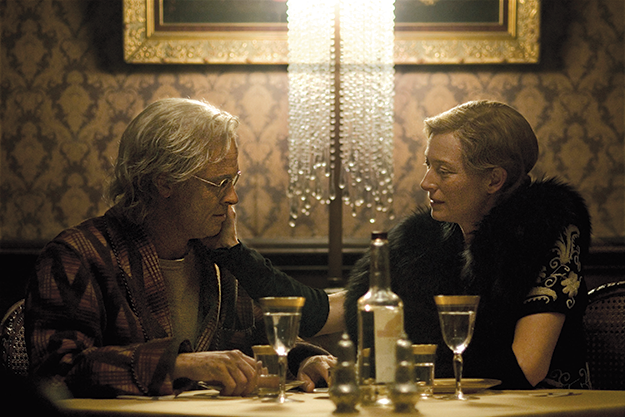
That’s so amazing. When you watch it, you never think twice about how could this be happening. It’s remarkable in terms of the technical invention, of course, but it’s also remarkable in terms of his performance—just in terms of his eyes and his line-readings.
I’ll tell you, it was almost the beginning and the end of my relationship with Digital Domain. We had done a commercial for Orville Redenbacher to do the proof of concept. Millions of dollars were spent. Marco Maldonado, who did all the tracking, he really figured that shit out. So on that commercial the tracking was perfect, but the skin shaders were horrible and the hair shaders were horrible. What ended up happening, because they are a vendor for commercial visual effects, was that they [Digital Domain] got railroaded into this schedule that precluded them really developing the facial capture side of the pipeline. So there was a lot of key-frame animation. And key-frame animation, as great as it is… Tom Hanks in Toy Story is as great as Tom Hanks has ever been—it’s amazing the distillation of all those moments and the risks the actor can take and with the voice and the things that they can try, and you can just use that line from here and this line from here, and you can create this thing that is perfectly timed because you can comb through it a thousand times and then you bring in really gifted people to figure out the facial contortions that are happening on top of it. But it’s a toy, and you do see Hanks through it sort of, but it’s like frozen concentrated. And the thing that we found on this Orville Redenbacher commercial was that all of the beautiful things that really talented animators bring to their craft ultimately are obfuscation when you’re talking about a performance. You can make a consistent performance of a character, but you can’t make it look like Brad Pitt. So we sat down and we had a come-to-Jesus, and I said, you guys got to figure out a way—I don’t want a Xerox machine, I don’t want you to plug this piece of software into another piece of software that’s off the shelf. I’m not talking about years of software development. You’ve got to find whatever worked on Beowulf and throw away whatever didn’t work, and you have to find whatever worked on Final Fantasy and you got to throw away whatever didn’t work, and you have to come back with something that’s ready to go. I can’t spend ten million dollars priming the pumps on this. You’ve gotta come back with a solution that works the first time.
And they did. They came up with a way. They culled through everything and sort of invented a way of daisy-chaining different technologies that made it possible for it to be Brad. And this is thing: I’d have these, well not fights, but circuitous conversations with Sherry Lansing, who I adore, but who would keep asking, ‘When does Brad come into the movie? And I’d say, will you stop with this fucking question, he’s going to be in the movie from the beginning to the end, and she’d be, “Yeah, but when does he come in?” and I’d say, “you’re just going to have to trust me.” And it was astounding, because he [Brad] would do the weirdest shit, I can imagine, it was like the first day of shooting on Pirates of the Caribbean and here comes Johnny Depp out of his trailer and his teeth are all gold and he has eyeliner on and this is what he’s doing? And you kind of go “Wow, it’s singular.” He [Brad] would do these things, like in the scene where he’s supposed to make a muscle. What Robert did in the scene was kind of sedate, he was just eyeing himself in the mirror like, wow, I am changing. And Brad came in and said, “I think he would just be so jacked, it’s like he’s out of his coffin.” So I said, “well, let’s try it.” He did it and I thought, this is ridiculous—I don’t know if this rig we built can capture anything this extreme, so I said let’s do another one, maybe a little more sedate, and he goes, “no, no let’s do this.” And we took that data and interpolated it with that 85-year-old face, and everyone just fell out of their chairs in dailies. You looked at it and went, oh my God, it’s character, it’s not a technique. It’s like when he learns to walk and he’s falling on his face, he’s toward camera and the look on Peter’s face was that he’s happy, his eyes are sort of wide-open. And then Brad came in and did this Popeye thing, and I thought, yeah your glasses are going to be all cocked and screwed up. And he did this whole thing where like one side of his face was scrunched up he looked like Popeye. And I said, I don’t know about this, and then when we saw it—Benjamin trying to walk—it was perfect.
So when you did the five days of motion capture with Brad alone, how was he framed? Was he acting full out with his whole body?
The cameras were on him like from the top of his chest to the top of his head and he had room on the sides to move around. Remember all of the movement he makes in the facial capture is cancelled out, so the movement doesn’t have to synchronize. We are just going to take the data of what his face is doing. So he was free do to it as he saw fit, and we just edited the sections that we wanted for the different shots and then they could apply the data of that facial contortion through the rig of him as an 80-year-old, and then we put that on the bodies of the actors who were there in New Orleans.
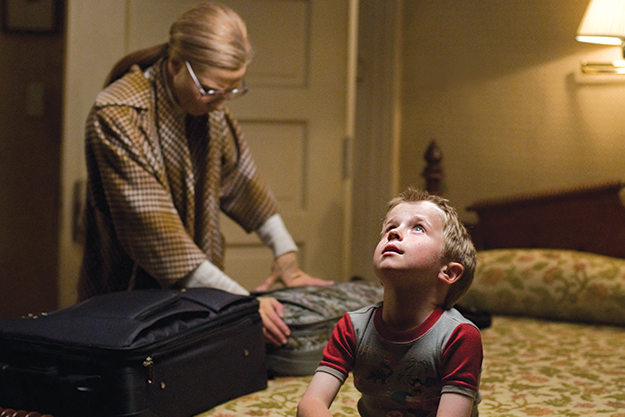
You know people are going to say, this isn’t a performance, it’s just some kind of animation, but I have endless admiration for him for having the technical chops to do that, and also to be able to play with another actor in a scene. Because the first full-out emotional scene in the film is the one with Tilda Swinton who is also remarkable. And that’s the first scene where the whole Brad—body and head together—appear to the screen.
Once everyone gets over the endless bizarre fascination that the tabloids have with him… it’s kind of like Paul Newman—you’re just amazingly handsome, amazingly handsome, amazingly handsome until you have a body of 20 or 30 movies, and then everyone goes, Wow, who knew.
Why couldn’t you use the same method when he’s a young boy as when he’s an old man? Once he’s regressed to 12 years, you begin using child actors to play Benjamin…
Not enough money. We could have, but it would have been a lot more expensive. When he’s 12, it’s Brad’s voice though. The actor who plays him when he’s sitting at the piano, we had to make his ears smaller, because Brad has these small ears. This kid looked a lot like Brad looked at that age but something was off… and then they made his ears smaller, and of course, that looks just like him.
So what proportion of shots were simply through the lens the way you shot them on the set and nothing else.
I would say more than half. All of the tugboat is blue-screened. There are matte paintings in and around the Nolan house, and then there’s the head replacement. Yeah, I’d say more than half. By the time you get to the Fortiess, we have a couple of matte paintings—to set up Paris and to set up New York, but for the most part, all that stuff is pretty straight. Same for the Sixties—and not counting make-up fixes where you have a piece of make-up that has to be blurred or fixed—yeah I’d say more than half. Does that surprise you?
No, I just didn’t have a sense of when it was and when it wasn’t. I mean I knew that wasn’t actually Paris actually in the Fifties, but mostly I forgot about it. Another question: did you choose the century references very carefully? One of the differences between this film and Forrest Gump is that Gump gives you just about every possible era reference, but here they were very sparing.
Yeah, we were staying away from that.
And the ones that are there are surprising: Carousel and the beatnik party, and Lincoln Kirsten and Balanchine…
And the Mercury Redstone. Imagine you are sailing along and you see the first launch of the Mercury Redstone from Cape Canaveral, and you go, “gee that’s pretty.” That’s the way Eric writes “They look over and see the first launch of the Mercury Redstone,” and you go… they don’t know it’s the Mercury Redstone. It’s just giant puffy clouds, so they go, “Look at that.” We tried to stay away… obviously you have to know where you are in time, and you do that with music and with hairstyles, and with colors and cars. But it was never going to be “ And now!!! Welcome to 1941!!!’
Sorry to be obsessive about this, but how many years from the time you actually started production until now?
I was hired to do a test and put together a budget and a schedule, I think in 2003. And then they shut us down for a few years and I went off to do Zodiac. And just before Zodiac, Katrina hit. And we sort of thought, Well, that’s off. And we sent the locations manager to New Orleans about six weeks after Katrina, and he called and said “It’s all still here, everything we want to get at. There’s no public works system and all the trolley shots we’re going to have to fake, but it’s basically still here, and if you want to risk it, come down. I don’t know if I can get you plywood to build sets, but there are hotels that are dying to put people up.” So we sort of rolled the dice at that point, and we went to the studios and we said we think we can do it for this number and they said, “Okay, that number, not a penny more, and we called Brad, we called Cate and said we’re on. October 2006. And we’d been talking about it for five years.
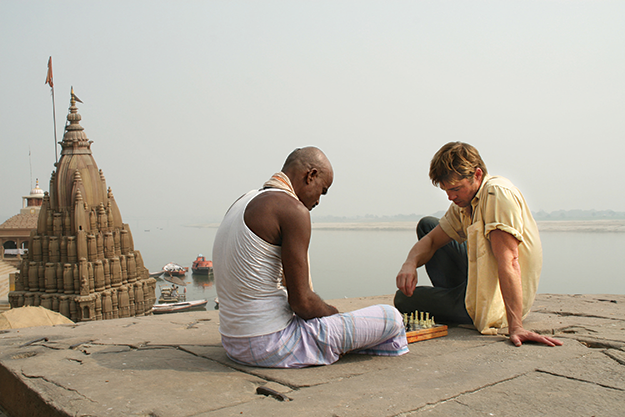
And working on the script at the same time?
We pretty much had the shooting script by 2003-2004. That’s what we turned in with our schedule, and that’s the thing they shut down. So we didn’t work on the script after that until we had actors in make-up chairs and we were gluing rubber to their faces, and then we would have these meetings, really great sort of fun story meetings, and talk about what people thought they could play and what they could bring to it or what he should do. Sort of revamping it as you do and tailoring things to things people want to say with the character. We did that for four or five weeks, and then we went down to New Orleans and started shooting.
It’s a silly question at this point, but did you ever consider making it on film?
There was no way to do it on film. We went all digital because I can do it in my office. We have the art department here, and we have PIX, so the editorial department and the production designer can draw up what a matte painting should look like and we can email that up to Matte World in Marin County and they can comment on it on PIX, and then they can redraw stuff, and we can say that’s it. And this is the locked picture and we can send them the plate and the zip drive FedEx—you don’t have to get into this whole thing of sending someone over to Deluxe and they get it to the negative cutter and then they have to cut it and make sure those are the frames we want, because, God forbid, we have to come back, and then … We just didn’t want to do that, so we thought we’ll just deal with this in the HD world that we already figured out for Zodiac, and only have to go a few steps further for Benjamin Button.
So is Paramount going to be limited to theaters that can show it digitally?
No, we’ll be striking prints the first week of December. And I saw one yesterday and it looks pretty good. It’s a little colorful, but…
But do you prefer showing it digitally?
Yeah.
It is an intensely romantic movie without the romanticism being limited to the romance per se. I think all your movies, except maybe Panic Room, aesthetically have their roots in 19th-century romanticism—the vision of mortality and the beauty of loss and decay. And it’s that wedded with the 21st-century technology makes them very powerful.
Well, the mortality was there in the script. That was the thing that I kept coming back to. You know we were discussing this the other day over at Paramount marketing. You have the two most beautiful people in the world on the poster for Dr. Zhivago, but you also have the Russian Revolution behind them. You know what’s going to get in the way. In this case, you can’t put a clock behind them. You know what I mean? And yet there’s something odd about it. I saw what the movie looked like in my head but it never occurred to me the sadness until we were actually making it. You see someone who’s 65 years old, but you don’t think, uh-oh, you’ve got 15 years. But when you see someone who’s aging backward and they’re 12, you just go, Oh [a sighed Oh]. Because I know what one through 12 is. I’ve seen it in my kid. It is an odd thing. If you saw two people meeting again in their seventies, it doesn’t seem as sad to me as when she’s 70 and he’s 20. I’ve got to tell you this story, I hope you’ll appreciate it. We had a sex scene in it, and Paramount was very… they said “You cannot have a 68-year-old woman have sex with a 20-year-old man.” And we said, well we’re going to. So we came in on the day, and we had these body doubles who were lovely, and we talked about what it was, and Brad talked about what he would do and I was sitting there and listening to all this and we were trying to rehearse this whole thing. And suddenly, I realized we could just fade to black, and then we just see this woman pulling her panty hose on and him watching her from behind. That’s going to speak volumes. Because it’s so vulnerable. She won’t face him, she’s hoping he’s not looking and it’s so human. You look at all the little buckles and rolls of flesh, stuffed into… it was really interesting. We would shoot the scene with Cate and then we’d bring the body double in, and I’d sort of apologize and say, “Okay, you’re pulling your top on here.” And she was wonderful and lovely. And we actually did end up shooting these six or seven shots for this [sex-scene] montage. And it was odd because Claudio [Miranda, the DP] had this beautiful soft light from the bathroom raked across the bed. And you couldn’t really tell. You could tell that he was twenty, but you couldn’t tell that she was 65 or 68. It wasn’t really making the point that I thought it would, so we went with pulling on the panty hose. But when I saw that moment, I thought we’re here to talk about that. It’s so important that he’s 22 and she’s in her sixties.
It’s both abstract and extremely emotional. The whole movie is like that.
I don’t know anymore. You see something a thousand times. I’m completely inert to it.
I’m very curious about what people are going to make of it?
As am I. But this is the part where you just want to hibernate and wake up eight months later. How did it all turn out? Am I persona non grata?



